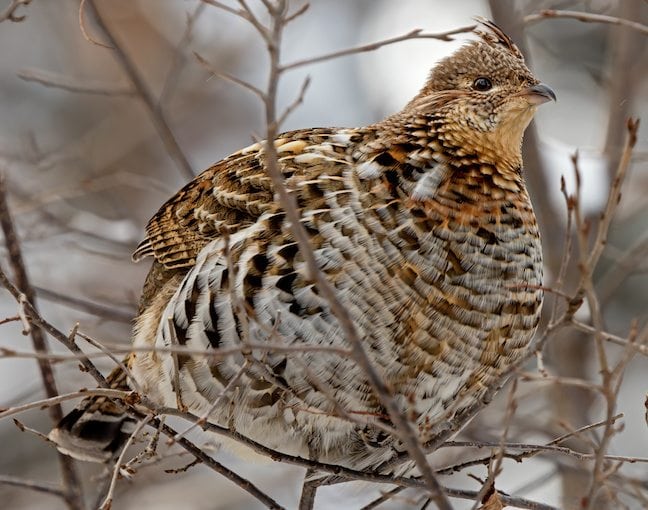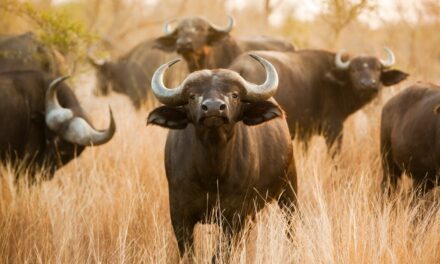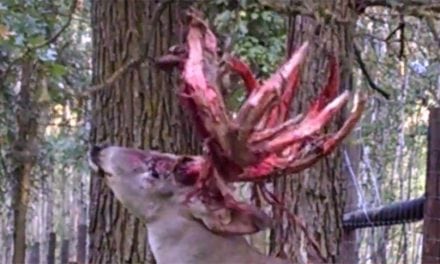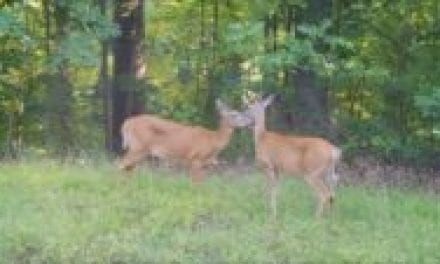According to the New York Department of Conservation, sometime between Sept. 2 when the grouse season opens in northern New York (and Oct. 1 in southern regions) and the close of the season on Feb. 28, about 75,000 hunters will take to the uplands in search of the state’s second most popular game bird. (Only the wild turkey is more popular.)
Despite declining grouse numbers in many areas, on average each hunter will take 11 trips and spend more than 30 hours afield in the pursuit of grouse. These guys are pretty hardcore, as it takes an average of more than 17 hours of hunting to kill a grouse.
The DEC assesses similar statistics for woodcock through its annual Grouse and Woodcock Hunters Log. According to the most recent report, on average each woodcock hunter took three trips to hunt woodcock and invested 23 hours hunting the fist-sized birds.
WHAT THE LOG SAYS ABOUT GROUSE
While these numbers from the 2016 Hunters Log may seem discouraging at first glance, hunting actually improved a bit from 2015 in some regions. Whether the slight improvements indicate a recovery of sorts in bird numbers or merely a seasonal upswing due to spring weather conditions and better recruitment is too early to say conclusively.
Continued monitoring through the Hunters Log and Ruffed Grouse Drumming Survey is needed. Nevertheless, the findings last year are somewhat encouraging and if 2017 is anything like 2016, hunters in some regions can expect to find more birds and have better gunning this fall, provided they are willing to commit a grouse-hunting level of time and effort in the pursuit

Ruffed Grouse (Shutterstock image)
Compared to 2015, flush rates increased in five of the state’s seven ecozones last year. Flush rates stayed about the same in the Mohawk Valley-Hudson Valley-Taconic Highland Zone and decreased slightly in the St. Lawrence Valley Zone.
Flush rates were up in Appalachian Hills and Plateau, Adirondack and Tug Hill, Catskills and Delaware Hills, Champlain Valley and Lake Plains zones. Although the flush rate was down a tad in the St. Lawrence Valley, hunters there still put up just under one bird per hour, the third highest flush rate in the state behind the Adirondacks-Tug Hill and Catskill-Delaware Hills zones, respectively.
It is also interesting to note about two-thirds of the hunter effort and over 60 percent of the birds harvested occurred during the first half of the season in September and December — but flush rates were actually higher during the late portion of the season from about mid-December through February. Also interesting is that more effort took place on public land.
Perhaps thanks to ongoing habitat improvements on some state forests and wildlife management areas, the number of birds flushed was slightly higher than in previous years on public land (although overall flush rates were still higher on private land). This is a surprising and encouraging change considering that in previous years hunter effort on public lands has been quite low and flush rates were less than impressive.
WHAT THE LOG SAYS ABOUT WOODCOCK
Woodcock hunters will be pleased to learn flush rates were up slightly from the previous five-year average, suggesting woodcock numbers could be gradually on the rise. On the other hand, according to the “Singing-ground Survey” (SGS) conducted by the U.S. Fish and Wildlife Service, the increase could be the result of good summer recruitment and not necessarily an indicator of steady population increase.
Taking that into consideration, bird numbers could fluctuate year-to-year. In 2013 and 2014 there was a decrease in the breeding index that resulted in low flush rates according to the SGS, but in 2015-2016 the breeding index saw an increase and hunters experienced slightly higher flush rates.
The latest hunters log also indicates woodcock flush rates were highest in the Lakes Plain ecozone — something of a surprise, because in recent survey years this was a region with one of the lowest grouse flush rates.

Woodcock. (Shutterstock image)
According to the SGS this suggests grouse and woodcock may not always be found in the same areas largely due to the woodcock’s migratory nature and ability to find small pockets of suitable early successional habitat such as young forests and shrub lands. Hunters might want to keep this in mind this fall when scouting for potential hotspots.
Hunters should also keep in mind that because woodcock are migratory, flush rates and success will depend on hunting during the peak migration, which can vary from year-to-year.
During four of the past six years the peak migration occurred during the last week of October, all of which saw mild weather conditions in October and an overlap in resident and migratory birds that resulted in higher flush rates throughout the month and peaking late.
During 2011 and 2014 colder weather and snow conditions in many areas saw the peak migration arrive earlier during the week of October 18 and low flush rates late in the month. Something else to keep in mind this fall.
FINDING HOTSPOTS
Productive grouse and woodcock ground will always include two key things: food and cover. But the areas that provide food and cover change depending upon the time of season.
Early in the gunning season wherever there is water, such as marsh edges, creek bottoms, the banks of brooks, spring seepages and damp alder thickets, air temperatures are coolest and grouse are drawn to these locations. These habitats typically also offer the dense cover and food such as wild grapes, raspberries and other bramble fruits grouse rely on to survive.
Because the ground is still soft well into late October and worms are still available these same locations also attract woodcock.
Grouse will also be found in other locations during the first half of the season, but food and cover will remain key. In late September and through October when early morning and late afternoon temperatures are frosty or cooling, grouse will seek sunny openings in old apple orchards, areas that have been cut or logged, and edges along fields. And keep in mind grouse also require gravel to help digest their food.
More from G&F on Bird Hunting
- Improve Dove Odds With Timing, Practice, Shot Pattern
- 7 Dove Hunting Mistakes to Avoid
- Great Grouse Hunting Dog Breeds
The edges of tote roads, logging roads, snowmobile and ATV trails and the like are also likely spots to find birds. These locations are typically bordered by thick cover, offer food and gravel, and provide a place to warm in the sun at the beginning of the day or before birds hit their roosts for the night.
Late in the season, woodcock haunts are pretty much frozen and local and migrant birds have headed south.
Grouse are still at hand, although the best grouse locations have changed with the season, especially once snow flies. The soft mast and fruits grouse depended on earlier in the season are gone and grouse will transition to feeding on poplar, willow, birch and other softwood buds.
They will also seek shelter from cold temperatures and winds. Areas where thick conifers and pines border these softwood stands offer sunny openings and both shelter and food. Thus, they are prime locations for late-season gunning opportunities.
To find these locations hunters have several options. One is to use bootleather and get out there and find them. A New York Atlas & Gazetteer is a great aid. Pick a likely location and spend a morning getting to know it. It is time-consuming and often a hit-or-miss proposition, but can be quite enjoyable.
Another way is to join a local rod and gun club or chapter of the Ruffed Grouse Society and American Woodcock Society. There are four local chapters here in New York located in different regions of the state. Not only are members avid hunters, but the chapters hold various hunting events and are involved in local habitat improvements, most often on public lands in conjunction with the DEC. It is a good way to get involved, learn about local hotspots, and improve habitat.
For local chapter information visit www.ruffedgrousesociety.org.
A third and sometimes time-saving way is to contact a regional DEC office or regional forestry office and talk to the wildlife and forestry staff personnel. These folks are in the field every day and are directly involved in habitat improvements on wildlife management areas and timber harvesting on state forests and other public lands. They also know of private property open to public hunting and can provide information on the best areas to hunt.
A list of DEC wildlife and forestry offices and personal will be found on the DEC web site at www.dec.ny.gov and are listed in the 2016-2016 Hunting & Trapping Guide.
SOME LOCAL POSSIBILITIES
Long Island Woodcock
Grouse may be off limits on Long Island, but Nassau and Suffolk counties offer some pretty good gunning for woodcock. The island has some resident birds but much of the action is provided by migrants that stop to rest and feed in the area’s moist, rich soil for earthworms. The best action will come during the peak of the migration, which can vary year-to-year, but as it is elsewhere in the state any time during the two-week October season can offer some challenging opportunities for hunters willing to put in the time and effort.
Some of the best woodcock habitat is found on DEC-managed lands and Cooperative Hunting Areas such as the Rocky Point Management Area and Otis Pike Preserve. Together the two properties offer about 11,000 acres of oak-pine forest, open fields, forest openings and pine barrens.
The Sarnoff Cooperative Hunting Area is another potential good spot. Information about more properties and particulars is available on the DEC web site, and the wildlife personnel at the DEC Region 1 office in Stony Brook can also suggest other areas by telephoning (631) 444-0310.
Hunters should keep in mind that along with a hunting license most DEC properties on Long Island require a Managed Land Access Permit, which are available on the DEC web site.
SOME WILDLIFE MANAGEMENT AREAS
Scattered in areas throughout the state are 110 wildlife management areas totaling nearly 197,000 acres. WMAs are good spots to look for both grouse and woodcock due to a diversity of natural habitats attractive to both species and because the DEC has completed or has in progress habitat management plans that call for habitat improvements beneficial to a variety of species over a 10-year period, including grouse and woodcock.
In Putnam County, DEC Region 3, the Cranberry Mountain WMA covers 1,085 acres of upland hardwoods and along with the 25 acres of field offers prime habitat and good edge cover for grouse, while the edges of six small ponds often attract woodcock. The nearby Great Swamp WMA in Patterson is also a great spot for both species. The property consists of 10 separate parcels, the largest 300-acre parcel located off CR 64.
In the DEC Region 4 town of Knox the Burke WMA covers 245 acres. It is part of Helderberg Bird Conservation Area, a 6,594-acre complex of hardwood and conifer plantations, young regenerating woodlands, old fields, shrub land, reverting farmland and wetland. That includes Partridge Run WMA and state forest and Cole Hill State Forest in Albany County.
To the north, in DEC Region 6, the Tug Hill WMA gets a lot of attention from bird hunters but time should also be invested getting to know the Indian River WMA in Theresa. The 968-acre property offers over 430 acres of upland forest, 25 acres of old reverting fields and over 500 acres of marsh, shrub swamp and assorted wetlands.
In Region 7 southeast of Cazenovia the Tioughnioga WMA offers a good mixture in the Appalachian Highlands. The property covers 3,737 acres of rolling hills and brushy uplands, conifer plantations, valley thickets and alder-covered creek bottom, all prime grouse and woodcock haunts.
To the west, Rattlesnake Hill WMA in the Region 8 town of Livingston has a mixture of mature wood lots, over grown fields, old-growth apple orchards plus some bottomland. The property covers some 5,000 acres and is adjacent to Ossian and Canaseraga state forests, offering an additional 2,500 acres.
And in Region 9 Hanging Bog WMA in Allegany County covers 4,500 acres of hardwood- and softwood-covered hills, small fields and bottomland. Considerable habitat improvements have made the property a favorite among local hunters. For woodcock, travel southwest of Canaseraga and hit the alder thickets of Keaney Swamp WMA in Birdsall or the upland cover of Keaney Swamp State Forest. Combined they offer over 3,100 acres of good ground.
These are just some examples of our public lands that offer gunning opportunities for grouse and woodcock. Most state forests are also under habitat improvement programs and offer good hunting. Good hunting is also possible within the Finger Lake National Forest in Schuyler and Seneca counties and on some 64,000 acres of the Fort Drum military base in Jefferson County. Additional information and contacts are available on the DEC web site.
The post Grouse and Woodcock Hunting In New York appeared first on Game & Fish.
















